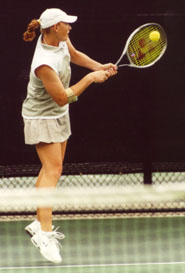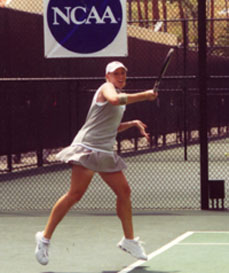Advice on Returning Serve
Stand up and take it early
by Ed Collins
Your return of serve starts improving once you begin playing
the ball from inside the baseline, early in the bounce. This helps in the
following ways:
1. It prevents the server from exploiting
angles.
2. It makes the server hit short (by
putting pressure on him to serve deep).
3. Your return gets back to the server quicker,
even before he regains his balance.
4. Against the serve-and-volleyer, it makes
him volley from farther back.
5. It enables you to chase down the short
volley.
6. It makes the return-and-volley play possible.
To improve your return, use this formula:
1. Stand up: on the first serve, stand at
least even with the baseline; on the second serve, move up a step
or two (closer, if the serve is weak.)
|
2. Hold your hands in front of your
body, get your weight forward, onto the balls of your feet, and lean
forward with your head and torso.
3. Watch the toss, to anticipate its
placement. (Look for the slice serve on the toss in front of the right
shoulder, the spin serve when it's behind the left shoulder, and the flat
serve when the toss is directly in line with the head.)
4. Time a step-and-split with the
toss-and-hit.
5. Time permitting, take two steps
forward to play the ball.
6. Abbreviate your backswing.
7. Hit the ball on a line, not up.
Hit it firmly, if not hard.
8. Aim at a spot approximately six
feet inside the sideline (the margin-for-error adds to your confidence
in hitting hard).
9. Practice the inside-out backhand
return from the deuce court. This makes the server move unnaturally to
his right. |



